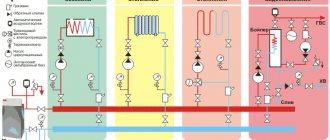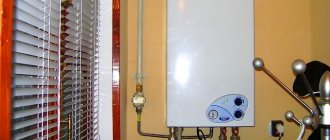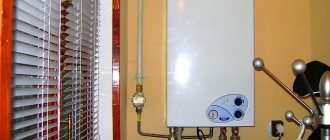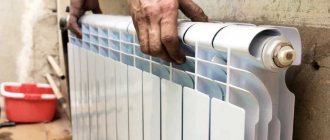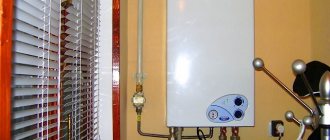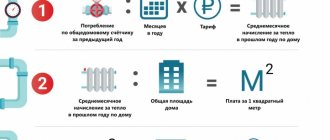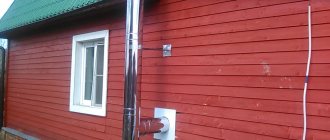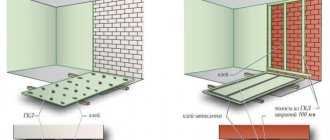Many people do not even suspect that it is possible to install individual heating in an apartment, as well as in a private house. However, for some apartment owners, the heating issue is so acute that they are seriously considering this option. Let's find out how realistic this is, what permits will be required and which autonomous heating system to prefer.
What makes residents of high-rise buildings think about abandoning central heating and connecting to an autonomous heating system? There are many reasons for this:
- unreasonable cost of utility bills;
- poor-quality heating, which cannot cope with maintaining a comfortable temperature in the home during the cold season without the use of additional heat sources;
- unfavorable location of the apartment, requiring more heat - corner room, first floor;
- dependence on the established dates for the beginning and end of the heating season, causing one to freeze in the fall and suffer from the heat in the spring;
- the need to maintain the desired temperature at any time, paying money only for actual heat consumption.
Advantages and disadvantages of independent heating
To understand whether it makes sense to abandon the central heating supply in favor of an autonomous one, it is worth weighing all the pros and cons of a separate option.
Advantages:
- Significant savings. According to reviews from owners who have switched to autonomous gas heating, the cost of heating an apartment is reduced by 6–7 times.
- Complete independence from the start and end of the heating season.
- The ability to adjust the temperature at your discretion. Some systems allow you to set the desired mode, in which the heating intensity changes at specified intervals. For example, when all family members are at work or school, the temperature drops by several degrees, and in the evening it rises again. This allows you to further increase your savings.
- Uninterrupted supply of hot water.
- Free choice of radiators. Any batteries are suitable for an individual system, since there is no possibility of water hammer.
Flaws:
- High cost of equipment.
- Dependence of modern boiler models on power supply.
- The need to install a new heating circuit.
- In many cases, there is a need to install a suitable exhaust duct.
You can learn more about the advantages and disadvantages of autonomous heating in an apartment in a multi-storey building from the owners’ words by watching the video.
Alternative space heating options
When planning to make individual heating in the apartments of an apartment building, you need to weigh the material component and choose a device. This is due to the fact that the equipment used in private cottages cannot be installed in apartment buildings.
Thus, the law prohibits the installation of solid and liquid fuel boilers in apartments. This is due to the fact that for stable operation of the equipment a supply of fuel is required, which in a high-rise building is dangerous.
A gas boiler
When installing an individual heat source, the owner must think not only about his own comfort, but also about the safety of other residents of a multi-story building. Installing underfloor heating or an electric heater is legal. In all other cases, it is necessary to obtain advice and assistance from technical and legal specialists.
Therefore, selecting the right equipment during the planning stage of an off-grid system is important because the boiler determines the success of the event. Despite the requirements and a number of restrictions, there are different techniques for autonomous heating. First of all, experts recommend considering gas fuel, but here we are not talking about cylinders, but exclusively about connecting to the main line.
The optimal equipment for individual heating is a wall-mounted double-circuit boiler, equipped with a thermostat and electronic ignition. In the economy segment such models are presented (Russia), in the premium class - Immergaz (Italy). This technique is capable of automatically maintaining a comfortable microclimate for a long time, providing not only heating of batteries, but also hot water.
Requirements for premises in an apartment where a gas boiler can be installed
The room in which it is planned to install a wall-mounted boiler must comply with the standards of Bill No. 190. Unlike electric fuel, gas is subject to increased safety requirements and placement conditions. By following the rules, the user receives a comfortable microenvironment and safety for all residents of the house.
Requirements for the room for installing individual heating:
- Area from 4 square meters. The ceiling height is from 2.5 m. The width of the door frame must be at least 80 cm.
- The presence of at least 1 window used as a natural type of lighting.
- You cannot install other equipment powered by gas or electricity within a radius of 30 cm.
- During installation of the unit, provision should be made for a chimney or forced ventilation. Fire-resistant material must be placed between the equipment and the wall.
- The boiler must be set up by a master.
For your information: SNiP 42-01-2002 covers the standards and requirements for the installation of gas equipment in a multi-family apartment.
Apartment IO diagram.
Autonomous electric heating system
A direct heating system is where electricity is converted into heat. For individual communications to supply resources to a house and/or apartment, several options for devices and circuits have been developed.
Using an electric boiler
Step-by-step algorithm for installing a wall-mounted boiler:
- The main difference between installing a gas unit from an electric device is the requirements for the procedure. As a rule, the first type of equipment requires a chimney and a ventilation system.
- An energy-fired boiler requires a water and sewer connection.
- To install the equipment, select only a load-bearing wall.
- Before installation, height parameters are measured for the optimal location of the unit. The marks are installed at a level of 1-1.5 meters from the floor. Then the strips are installed.
- When carrying out work yourself, you must follow the instructions supplied with the heating boiler. The technical data sheet describes in detail the installation algorithm, possible errors and elimination methods. Experts recommend contacting official employees of the Gorgaz company.
- The connection options - coupling, thread, flange - depend on the type of pipes and engineering elements used. The use of fittings and materials for cold welding is allowed.
When planning to abandon central heating in your apartment and switch to individual heating, you should be prepared. A citizen will need to spend a lot of personal time and budget to purchase equipment and utility items. In some cases, this procedure requires major repairs in a separate room.
The principle is that during work, strictly act within the framework of legal norms and regulations for installation of the heating unit and maintenance. Otherwise, in the future, when using the equipment, breakdowns, freezing of the thermostat, etc. may occur.
Heating of premises with electrical appliances
Electric radiators are a simple type of device from the “converters” category. The principle of operation of the device is that 2 electrodes are lowered into an electrolyte (in this case, mineral oil). Energy passing through a substance heats the mass.
Taking into account the high temperature regime and excellent thermal energy transfer rates, the surface of the unit becomes hot in ~7 minutes. However, the resource fee is high, since heating requires constantly turning on the device.
Electric heaters in the individual heating system in apartment buildings
Autonomous heating in an apartment building can be carried out by connecting electrical appliances.
The table shows the types of devices, their parameters, as well as positive and negative aspects:
Table 2.
| Name | Principle | Distinctive features | Note |
| Convectors | Heating of the heat exchanger with further operation like a standard battery. | Completely ready for heating. It is prohibited to independently change the number of sections. Beneficial in terms of budget savings. | In appearance they do not differ from modern bimetallic radiators. |
| Oil radiators, ceramic and quartz panels | Direct heat transfer from the surface of the device. | Positive features: • you won’t have to pay much; • ease of operation; • no need to install equipment; • the ability to move the unit to another room; • safety at work – the presence of a protective system. Negative aspects: • the surface heats up slowly – it takes 30 minutes to heat a room of 16 m2; • large dimensions and weight; • bad design; • Caution is required. | To increase the heating effect, it is necessary to increase the area of the panels. |
| Heat fans | Forced creation of air flow. | The presence of a built-in fan is both a minus and a plus. On the one hand - ease of operation, on the other - the element consumes electricity | The operating principle is similar to heat guns. |
| Infrared heaters | Directional waves must come into contact with an opaque obstacle. Pushing off from the surface of the obstacle, heat is generated and transferred through the air. | Various models available - mobile, stationary, wall-mounted. | This category also includes film infrared systems. |
Warm floor system
If you turn off the heating in the apartment and switch to autonomous heat supply, then as an alternative you can use a heated floor system. The circuit is represented by a set of heating elements - mats or wires.
When the device is activated, energy is converted into heat emanating from the floor. This principle of operation is optimal, since the surface is uniformly heated, and the difference in temperature conditions at the top and bottom is practically reduced to zero.
The system is equipped with sensors that regulate the microclimate in the rooms. When the maximum user-specified level is reached, the heating automatically turns off. Accordingly, and vice versa, as soon as the temperature begins to drop, heating is activated.
Thus, the owner has his own heating system without resorting to central heating. Payment is made using an electric meter.
Advantages of “warm floors”:
- the device does not dry out the air – the humidity level remains comfortable;
- the equipment is safe for people and animals;
- The rooms warm up as quickly as possible.
What is autonomous heating?
The transition to individual heating of an apartment involves abandoning the use of a common building heating system and dismantling the radiators and pipes associated with it. Instead, new lines and batteries are installed, which are connected to the heater. Two types of installations are traditionally used in apartments - gas and electric boilers. The principle of operation of the device is simple: it increases the temperature of the water and forces it to circulate through the system, heating the room in the desired mode.
USEFUL INFORMATION: How to hide heating pipes in an apartment
Boiler types
All devices can also be divided into two types:
- single-circuit – working exclusively for heating;
- double-circuit – additionally providing hot water supply.
Depending on the installation method, heating boilers can be wall-mounted (as in the next photo) or floor-mounted. The former are more popular due to their compactness and lower price. The latter have greater power and a long service life.
Electric boilers
Installations powered by electricity are affordable and have a high level of safety. They can be installed anywhere in the apartment. Unfortunately, such a unit is not suitable for a house with old wiring due to the risk of constantly knocking out plugs.
Gas boilers
Gas appliances are more expensive, but they last a long time and quickly pay for themselves during operation, since they use a cheaper source of energy. A gas-powered heater has a special combustion chamber and a smoke exhaust system to avoid any inconvenience to the residents of the apartment.
The choice of boiler depends on many conditions, including the size of the home, so its choice must be approached very responsibly.
Advice. It is believed that to heat a standard room with a three-meter high ceiling and an area of 10 m2, 1 kW of heating boiler power is needed. To calculate the required resource of a heating device, divide the area of the room by 10.
How to choose a boiler?
Having decided on the power of the boiler, proceed to choosing its type . The boiler can be single-circuit (i.e., intended only for heating) or double-circuit (in addition to heating, the boiler heats water).
Next you need to decide on the type of fuel. Boilers are single-fuel (gas boilers or electric boilers) and combined type, that is, they can operate on different types of fuel (for example, gas + electricity or gas + liquid fuel + electricity).
It is also worth considering when choosing a boiler - the material of manufacture; This factor affects the lifespan of the equipment. Boilers made of steel or cast iron are quite heavy and more difficult to install, but they last a long time.
A gas boiler
Autonomous gas heating is the most relevant today, since gas is considered the cheapest type of fuel.
A closed-type gas wall-mounted boiler with a combustion chamber, according to experts, is the best option for home heating today. It has a horizontal smoke exhaust system, due to which carbon monoxide escapes to the street.
Advantages of a gas boiler:
- silent operation;
- multi-level security system;
- maintaining the required temperature in the apartment, regardless of gas pressure;
- acceptable price.
Electric boiler
Electric heating can be the main or additional heating option. The system is easy to use, easy to install, and takes up little space.
Electric boilers can be wall-mounted or floor-mounted . Both options are effective, silent, and functional.
Electric heating is less in demand than gas heating, but in the future, perhaps, this type of fuel will become more relevant.
Heating scheme
In centralized heat supply, a single-pipe scheme is used, which is inferior in efficiency to a two-pipe scheme. The single-pipe system is used only for a small number of radiators in situations where savings are needed.
The optimal choice for individual heating is a two-pipe scheme. It has the following advantages:
- use of pipes and fittings of smaller diameter;
- high pressure stability in the system;
- the possibility of installing automatic flow regulators on all batteries, which will operate without compromising the heating of other radiators;
- independent connection of each heating section, allowing it to be removed for maintenance or gaining access to the niche during repairs.
USEFUL INFORMATION: How to choose an air humidifier for an apartment: battery-powered humidifiers
Is it possible to do the installation yourself?
In order not to hire specialists, but to do the installation yourself, you need to know how individual heating works. But even after studying all the nuances, such actions as installing the boiler and auxiliary equipment, connecting gas and laying risers should be carried out by specialists from the relevant services. But everyone can install radiators. The main thing is to check the tightness before using the system. Leaks are usually detected at the junctions of radiator sections or pipes and radiators. A reliable way to check for leaks is to let coolant into the system. You must be prepared to immediately fix the leak so as not to flood your neighbors.
Is it legal to install an individual heating system?
There are many disputes and lawsuits on the legality of autonomous heat supply equipment in a separate apartment. It all started with the fact that in 2010 the Government of the Russian Federation banned the disconnection from the general heat supply and the transfer to individual heating systems, forcing many people to give up. However, already in 2012, a new resolution was adopted regarding the procedure for connecting heating systems. It provides a list of heat sources that are prohibited for use in apartments. This list does not include modern certified heating boilers. Consequently, the legislation does not prohibit the installation of your own heating, and all restrictions relate only to the technical characteristics of heating devices.
This does not mean that the owner of the premises can freely install individual heating. Before refurbishing, you must obtain permission from the local government. If the administration refuses to issue it on the basis of Art. 14 of the Federal Law “On Heat Supply”, you can safely go to court, since such a refusal is illegal.
Sample list of documents
Since installing your own heating system refers to the refurbishment of a residential premises, the list will include:
- an application drawn up in a special form;
- documents establishing the right to own housing: state registration certificate, deed of transfer of ownership, gift agreement, document confirming the right of inheritance (originals or copies certified by a notary);
- certified copies for each owner and a statement signed by all owners (if the apartment is in shared ownership);
- a copy of the technical passport of the premises;
- consent of family members of the tenant and residents of the apartment building, documented in the form of minutes of the meeting of apartment owners (if the area is municipal);
- conclusion of the body responsible for the protection of architectural monuments, historical or cultural heritage on the possibility of redevelopment (if the house is an architectural, cultural or historical value).
USEFUL INFORMATION: The heating was on, but the radiators remained cold: what to do
The most difficult thing will be to prepare and provide technical documentation. These include:
- redevelopment project for the installation of a gas boiler, including gasification of the premises and changes to the central heating system;
- a copy of the passport for the electric boiler, technical conditions, agreement confirming the permission of the maximum power, which exceeds the capabilities of the boiler (when choosing an electric heating device);
- Specifications for disconnecting the wiring in the apartment from the communal heating system;
- Specifications for ventilation;
- Specifications for supplying gas networks.
Legislative regulation in 2020
The procedure for installing individual heating in an apartment building is clearly regulated in the 2022 legislation.
Thus, the regulations on this issue are:
- The Housing Code (Article No. 26) establishes standards for redevelopment, indicates a list of required papers and covers the main aspects of re-equipping residential premises.
- Federal Law No. 190 of 2010 (as amended in 2022) in Article No. 14 defines:
- the need to connect to the heat supply infrastructure and conclude a contract with the supplier;
- situations when it is impossible to establish a connection to a centralized system;
- general standards and procedure for installing communications for individual heating.
- Government Decree No. 1314 approves the rules for connecting buildings to gas networks. The document explains:
- how the connectivity of an object is determined;
- procedure;
- requirements for project papers;
- other.
For your information: the laws of 2022 no longer apply to PP No. 307 dated April 16, 12. The document contained information about connecting to the heating system and the registration procedure. To replace this regulatory act, the Russian Federation developed PP No. 354.
The provisions provide an explanation of the criteria for selecting a heat supplier, options for sending documentation and concluding a contract. The main thing you should rely on when planning the transition to an autonomous system is the approved energy sources that are prohibited from being used for individual heating.
SNiP on the use of an autonomous heat supply system
In accordance with SNiP No. 31-01-2003, in particular clause 7.3.7, the use of a separate heating system is allowed in new buildings, which initially included the possibility of individual heating in each apartment.
It is allowed to abandon the central system with a subsequent transition to autonomous generators if the equipment has a closed combustion chamber and runs on natural gas.
At the same time, there is the corresponding design documentation for the engineering communications of the apartment building:
- general heating of a high-rise building;
- gas supply system, including unit and input circuit;
- smoke removal and air supply for fuel operation;
- The room area is more than 15 m2.
It may or may not be possible to disconnect a separate apartment from the central heating system.
The procedure for dismantling old heat supply devices does not yet indicate that heating was not consumed. Since the supply of the resource to the house was carried out and distributed along the risers. Therefore, the owners need to submit an application and approve the project. After receiving permission, work can begin.
Note: apartment owners who have written a waiver of the central heating system will make contributions only for personal consumption of the resource.
However, the Housing Code of Russia (Article No. 30, ) states that citizens, if they want to turn off the central heating system, will still pay for heat supply. This is due to the fact that fuel is used for general household needs.
Where to get the necessary documents
Collecting the required papers can take a lot of time and effort, because you will have to contact many services and organizations.
- For permission to disconnect your apartment from the general heating system, go to the city heating network. A refusal can be obtained only in one case: if the removal of radiators leads to disruption of the operation of equipment in neighboring apartments.
- Specifications for installation of a gas installation are provided by the gas service. To receive them, you need to go to the district housing office, from where a letter with the request is sent to the department.
- The refurbishment plan is handled by the design organization. This document should contain all information about the future system, technical solutions and calculations.
- A completed redevelopment project requires approval from the authorities from which the specifications were received, as well as the fire service and SES authorities.
Connection
Heating connection occurs after the conclusion of an appropriate agreement between the owner of the building and the organization providing this service. There are three options for connecting central heating to a private house:
- dependent direct-flow circuit;
- independent circuit;
- dependent circuit with installation of an elevator.
Each house heating scheme presented above has its own advantages and disadvantages, which must be taken into account.
What to do when permission is received
If everything was done correctly and you managed to get a positive response, the next step will be to purchase equipment and conclude an agreement with an organization that will install autonomous heating.
When, finally, the re-equipment is completed, and all the work on installing the new system has been carried out, all that remains is to go through several more city organizations and receive an acceptance certificate. This will be the end of the official registration of the installation of individual heating.
If there are no financial restrictions, you can save yourself from visiting offices and, for a separate fee, entrust the preparation of all approvals and documents to the design service.
The following video discusses the operating features of the most popular heater model - a gas boiler.
Installation process
Installation work to install the heating system is carried out in accordance with technological requirements and is carried out in several stages. Failure to comply with clear rules and requirements can cause incorrect operation of the equipment and lead to an emergency.
Marking
First of all, markings are applied in places where pipes will pass and radiators will be installed.
In order for the elements of the highway to be at the same level, as required by the technology, marks are placed using a level.
Radiator installation
At the next stage, the batteries are attached to their seats. To do this, holes for fasteners are drilled at the marked points with a hammer drill, which need to be secured with dowels.
Radiators are hung on the installed fasteners, and fittings are screwed to them.
Pipe laying
Then they begin to pull the pipes. Their assembly begins from the beginning of the wiring and, accordingly, the return. Using a soldering iron, fittings are welded to the edges of the pipes that will connect the line to the heating boiler. The soldering process consists of stripping the edges of the pipes from foil and inserting them into the nozzle of a heated soldering iron; in parallel, the fitting is heated in the same way to the desired temperature (usually 260 °C).
Next, the parts are joined with hot edges in a straight line and pressed tightly - this forms a homogeneous permanent connection. Similarly, the edges of the contour parts are connected along the entire perimeter of the apartment. To avoid deformation of the pipes, they are fixed to the wall with fasteners every 65–70 cm.
At the junction of radiators with plastic elements of the heating system, corner valves are welded. The system is ready for connection to a gas boiler, the installation and connection of which is best left to qualified specialists due to the complexity of the work and increased safety measures for its implementation.
